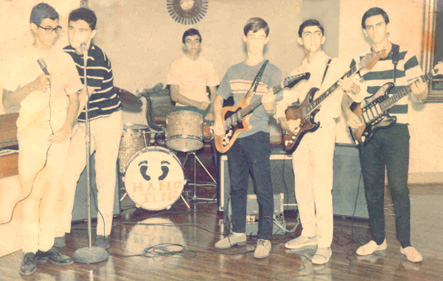 LOS HANG TEN'S
LOS HANG TEN'S 
 LOS HANG TEN'S
LOS HANG TEN'S 
Among the many rock bands that started to play in 1964, Los Hang Ten's was one of the few that was formed without the pretension of becoming a professional group. It was mid 1964, when a group of young high school students headed by brothers Freddy and Jose Rizo-Patron (lead and rhythm guitar), Diego García-Sayán Larrabure (drums), Ramon de Orbegoso (electric bass and later lead guitar when Jose Rizo-Patron left the group), and Felipe Larrabure (lead vocals) formed the group Los Hang Ten's. The origin of the name is a reference to a difficult surfing position, and to the Rizo-Patron brothers' penchant for the sport, one of the most popular in the coast of Peru.
The members of Los Hang Ten's were primarily from Santa Maria high school. Their main purpose of getting together was their love for music and to entertain their friends. Heavily influenced by The Kinks, Beach Boys and Rolling Stones, they also admired The Beatles and included many of their songs in their repertoire.
From their beginnings, until the group disbanded in 1968, the group members were young aficionados, their ages fluctuated from 14 to 17 years old, from the beautiful district of San Isidro. Some of the members were Manuel Sanguinetti (singer), Arturo Rodrigo (percussion, who joined the group in 1966), Juan De Aliaga (rhythm guitar from 1966 to 1967), Jaime Sabal (electric bass), and finally Guillermo Perez-Argúello, who joined the group in 1967, and shared the lead vocalist position with Felipe Larrabure.
What started as a means to acquire musical abilities, and a form of entertainment, became almost a full time occupation when the group got hired to play in festivals, private parties and even some public concerts, held at the time in movie theaters during the weekends.
In 1966, Odeon, at the time one of the major Peruvian labels,
invited them to record their first single. The 45 RPM had a cover version of the
Kink's "Till the end of
the day" on one side, and a blistering, unusual version of Nancy Sinatra's
"These boots were
made for walking", on the flip side. This single was recorded with all the
original members plus Arturo Rodrigo, who played the tambourine in that
recording, but left the group shortly afterwards. Today, due to the small run of
original copies, this single is a very desirable collector's piece.
In 1967, Jose and Freddy Rizo-Patron, left the group to join
Manuel Sanguinetti, a lead singer and a former classmate, who wanted to form a
more professional, tighter outfit. That group, with several key additions
eventually became Traffic
Sound, one of the most influential and creative groups that emerged from the rock 'n'
roll scene in Peru in the 60's.
1968 marked the end of the musical rite of passage for some of
the members, who decided to pursue formal academic education, each to enter
universities both in Peru and abroad. Today, they are successful
professionals in many fields of science and arts. Even after thirty years have
passed, they still jam together occasionally.

The picture above was taken in the
García-Sayán estate in April 1967. The musicians are, from left to right:
Felipe Larrabure Aramburú (lead vocals and founding member), Guillermo Perez-Argúello
(lead vocals since 1967), Diego García-Sayán Larrabure (drums and founding
member), Ramon de Orbegoso Elejalde (bass 1964-1967, lead guitar since 1967,
founding member), Jaime Sabal Saba (bass since 1967) and, Juan de Aliaga
Fernandini (rhythm guitar since 1967).
 Recording
by Los Hang Ten's
Recording
by Los Hang Ten'sLos Hang Ten's : 45 RPM , Odeon 45-9671 (Nov.-1966)
"Till the end of the day" / "These boots were made for
walking"
By George Bonilla Copyright ©2001 Lazarus Audio Products
Acknowledgments: thanks Guillermo Perez-Argúello for your priceless contribution.